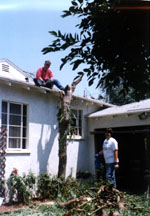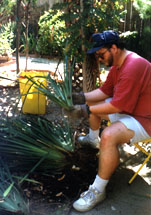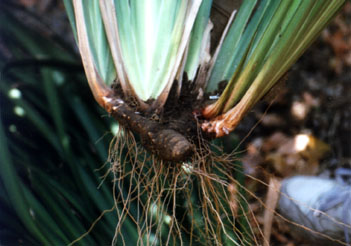
February 1997

February 1997
Catching Up
Without a digital camera, the process of getting photos for a web page can be a little time consuming. Below I have included a few pictures that depict previous activities in my garden.
Our first major project upon moving in was removing a badly placed willow tree. Here is an image with Banzai Douglas and Danger Ric removing said willow. You can read about the removal of this tree in October's Column.
 My JFK roses have finally hit their full bloom with tens of huge,
white blossoms and a smell that carries throughout the garden.
I have another special, yet unidentified blood red rose that has
also sprung into beautiful blooms. "Bewitched", large, prolific
pink roses continue to bloom in my three large, front yard beds.
I recently discovered that these roses were named after the 1960's
television show. Who would have thought?
My JFK roses have finally hit their full bloom with tens of huge,
white blossoms and a smell that carries throughout the garden.
I have another special, yet unidentified blood red rose that has
also sprung into beautiful blooms. "Bewitched", large, prolific
pink roses continue to bloom in my three large, front yard beds.
I recently discovered that these roses were named after the 1960's
television show. Who would have thought?
Time Away
Life intrudes on everyone's gardening time and mine is certainly no exception. The last month has found me spending hours at the computer writing and traveling on a speaking engagement in Dallas. The garden has had to wait and make due with basic maintenance and watering.
I was most disappointed to miss the first rain of the season and our residence in the new house. I was worried about leaking roofs and muddy planting beds, but all came through with flying colors. Still, I was disappointed to not be able to see the effects first hand. While not as important as missing your child's first steps, it has a certain tinge of regret.
After returning from my trip I have had to re-dedicate myself to some garden projects including one that we started way back in September.
Wildflowers
In my October column I also discussed our conversion of a small piece of lawn (the only patch on the property) into a native plant garden. After adding a pickup load of compost and turning the soil with a rototiller we covered the area in plastic while we waited for a native plant sale. The plastic covering was part of a technique called solarization. Supposedly, the heat generated by the sun will kill bad bacteria and fungi as well as the grass rhizomes and weed seeds. It seems to have worked. After planting the native perennials I began to water the entire area to see if any weeds would sprout. To my surprise, I didn't seen any of consequence.
Just last week we started the next stage of this native garden project. Since I only purchased 10 perennials shrubs I still had plenty of space to fill. I added a flagstone path that arced through the bed in preparation for a 2 person glider or swing that my wife wants to add. Then, I broke up the soil crust and planted one container of wildflower seed that we had purchased, on sale, at The Nature Company. I was a little worried about the success of this planting after the failure of my sunflower seeds and catnip, but noticed that there were few sow bugs in this new bed. As I write, only 10 days later, I am beginning to see a green carpet spread over the entire area. Birds have eaten a few of the seeds around the feeder, but elsewhere the germination is good. In a few months I should have a beautiful wildflower meadow that will be low maintenance as well.
Divide and Conquer
Due to the age of the garden I have several overgrown plants that are in desperate need of trimming and division. My sprawling yellow lantana finally passed out of bloom so I took the opportunity to prune it back severely. It had wandered laterally out of its bed and threatened to block the pathway. I saved the vertical branches to give it some height and trimmed the horizontals back with the bed borders. Already I am seeing leave sprouts on the cut branches. It should be in full vigor again by next summer.
Another series of overgrown plants are the Morea (Dietes vegeta), also known as the Fortnight Lily. They are commonly used as landscape plants throughout Southern California. They have long, erect iris-like leaves and small, white flowers shaped like a Japanese iris. After several seasons they become overgrown and the flower stalks begin trailing on the ground since they cannot get enough space or light to stand erect. Sometimes gardeners will merely lop off the top 3/4 of leaves and remove some internal leaves down to the ground. This leaves an ugly, ragged brown-edged appearance to the plant that I find disagreeable. I instead divided one Morea by digging it out and dividing the rhizome, much as one would with an iris. The success of my division is yet to be seen as the plants are slow to recover.
I replanted the new divisions so that their growth was away from an adjoining sidewalk to free up another walkway. It should be years before I am forced to divide this particular bed again.
Below are pictures of myself dividing the rhizome and a close-up of the rhizome itself.

The Author Dividing Morea Rhizome

Morea Rhizome
Bulbs, Bulbs, Bulbs
This month brought another pleasant surprise in the garden. I had mentioned that everywhere I turned soil I also turned up bulbs. Well, this month these bulbs are beginning to explode form the ground in almost every bed. I have my first paperwhites blooming as I write and there are 40-50 more still pushing up from the ground. I have seen pictures of amaryllis in the garden as well, but I am unsure where they are. I am making careful notes in my journal so that I can be prepared for this show in coming years. As one of my friends from the GARDENS mailing list said, "These bulbs are much like holiday presents. They come wrapped and reveal themselves slowly but are very welcome."
Close Encounters of the Bird Kind
One way I measure the success of my garden is by the wildlife I attract. I have seen Viceroy and Monarch butterflies, other butterflies and moths, praying mantis, grasshoppers and much more. You have heard about my opossum in earlier columns. This month yielded 2 unexpected sightings that thrilled me.
The first sighting shocked me. I was sitting in my office, writing, and watching the birds at the feeders while I thought. Always on the lookout for new species I noticed a striking bird with a blue back sitting in the limbs above the feeder. He was difficult to see on the limb but finally he flew to the feeder and allowed me a better look. It was a small blue parakeet much like the ones people keep for pets. I assume that he was an escapee from some home. He appeared fit enough, but I have not seen him since.
The next visitor to my garden seems to have taken up residence. I live in the middle of a typical 1940's-50' style sub-division, so I was surprised to find a California Quail sitting under one of my feeders. They are normally very shy and only found in less populated areas. Since my first sighting he seems to have taken up residence in a tree in my back garden. We see him at the feeders regularly and he always returns to this same tree when spooked.
An upcoming project calls for the planting of a hummingbird garden to give these delightful birds a change from the usual sugar-water diets of most feeders.
Next month brings information on that project as well as a native garden update, rose pruning notes, and preparations for expanding my small herb garden.
Until then, keep digging...
Douglas E. Welch
© 1997 Douglas E. Welch